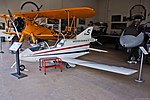Torrance Memorial Medical Center
1925 establishments in CaliforniaBuildings and structures in Torrance, CaliforniaHospital buildings completed in 1971Hospitals established in 1925Hospitals in Los Angeles County, California ... and 1 more
Use mdy dates from June 2023

Torrance Memorial Medical Center is a private hospital located in Torrance, California. Torrance Memorial was the first hospital in the South Bay region and is currently one of the three burn centers in Los Angeles County.
Excerpt from the Wikipedia article Torrance Memorial Medical Center (License: CC BY-SA 3.0, Authors, Images).Torrance Memorial Medical Center
Lomita Boulevard, Torrance
Geographical coordinates (GPS) Address Phone number Website External links Nearby Places Show on map
Geographical coordinates (GPS)
| Latitude | Longitude |
|---|---|
| N 33.812 ° | E -118.343 ° |
Address
Torrance Memorial
Lomita Boulevard 3330
90505 Torrance
California, United States
Open on Google Maps






